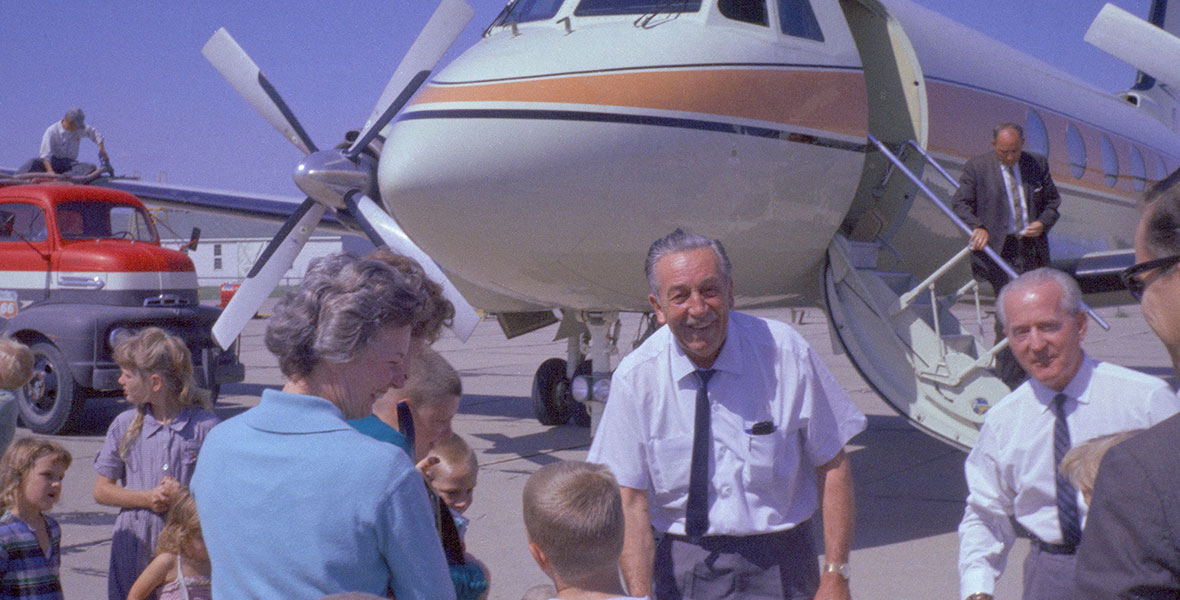By Alison Statemann
In just over a week’s time, Disney fans at D23 Expo 2022 will be able to view an artifact steeped in Disney history—Walt Disney’s treasured Grumman Gulfstream I. The aircraft was the last of three company planes Walt employed during his lifetime and played a pivotal role in Company milestones, including its participation in the 1964-1965 New York World’s Fair, the development of Walt Disney World Resort, and other promotional and goodwill activities. Often known simply as “Walt’s Plane” or “The Mouse,” it was a source of pride and joy to Walt as well.
The newly refurbished aircraft is the centerpiece of the exhibit Mickey Mouse One: Walt’s Plane Presented by Amazon created in collaboration with D23 and the Walt Disney Archives, which is being staged at the Anaheim Convention Center for the Expo. The all-new exhibit will feature specially selected items that represent the history of the aircraft, including a customized instrument panel that was originally located near Walt’s favored onboard seat where he would use it to monitor flight conditions; a telephone handset with a direct line to the cockpit; and flight bag adorned with an image of Mickey Mouse sitting on the tail of the famed plane.
D23 recently spoke to Disney Legend, retired Walt Disney Imagineer, and frequent Gulfstream passenger Bob Gurr for a first-person account of what the plane meant to Walt and The Walt Disney Company.
D23: You were there from the beginning. Can you share some of the experiences you had on Walt’s Plane?
Bob Gurr: Well, very shortly [after purchasing it] we were using the plane primarily for transporting a lot of Imagineers back and forth, almost daily it seemed to New York [for the 1964-1965 World’s Fair]. The airplane became the most highly utilized Gulfstream—because other corporations bought them, but boy we bought it and we used it. We ran the wheels off the thing! It was busy all the time, and that’s why we had to have several flight crews because there’s time restrictions for flights and stuff. It was enjoyed by us executives and the Disney family.
D23: You were also a passenger on follow-up trips to Orlando for the development of Walt Disney World. What was that like?
BG: I was on one flight. There were several people on it. I think Edna Disney was on it and they said, “We’re going to show you what we bought.” I remember being so impressed with the pilot, Jim Stevenson. He said, “We’re going to go down 2,000 feet and we’re going to slow down, put the flaps out, and we’re going to drive around the property lines so you can see what we’re going to do.”
And I remember taking photographs out the window and it was all swamps. What on earth? That left an impression on me so strong as to what we are going to do down there in Orlando. That was quite a ride in The Mouse that day.
D23: What role would you say The Mouse played?
BG: The Mouse was central to the whole idea of entertainment—that the plane was a very special team member. It would go to different cities for promotions of movies. The pre-publicity for these flights is very well-planned in advance. The local news people are all well-briefed; they know what’s coming, and why and who the people are that will be there. People are in a place where they see the plane drive up because it usually goes to the smaller airports. So, the airplane arrives in a grand style. In the world of corporate airplanes, The Mouse was very special. It almost had its own character, its own personality. And it got noticed all the time.
D23: How did the plane get its nickname?
BG: The Mouse got the name primarily because when you’re a pilot and you use your [plane’s] tail number to identify yourself to [air traffic controllers], you call “Gulfstream 234 metro, metro”—but it didn’t take long for our guys to test it a bit. So, you call “Gulfstream 234 metro, metro,” and then the controller comes out, “Yeah, metro, metro,” and then on your next call you say “Gulfstream 234 Mickey Mouse.” You are not supposed to do that because all airplanes are on the same frequency. It’s like a party line. And the other corporate pilots said, “Well that’s not fair. How come Mickey Mouse gets a free pass to not use ‘metro, metro’?” So, it was a very sweet arrangement. The airplane just began to be called The Mouse. It became really easy to say, “Where’s The Mouse going today?”


